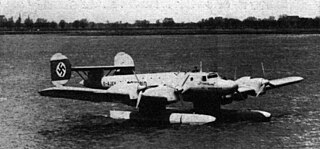Related Research Articles

The Blohm & Voss BV 155 was a German high-altitude interceptor aircraft intended to be used by the Luftwaffe against raids by USAAF Boeing B-29 Superfortresses. Work started on the design as the Messerschmitt Me 155 in 1942, but the project went through a protracted development period and change of ownership, and prototypes were still under test and development when World War II ended.
Hamburger Flugzeugbau (HFB) was an aircraft manufacturer, located primarily in the Finkenwerder quarter of Hamburg, Germany. Established in 1933 as an offshoot of Blohm & Voss shipbuilders, it later became an operating division within its parent company and was known as Abteilung Flugzeugbau der Schiffswerft Blohm & Voss from 1937 until it ceased operation at the end of World War II. In the postwar period it was revived as an independent company under its original name and subsequently joined several consortia before being merged to form Messerschmitt-Bölkow-Blohm (MBB). It participates in the present day Airbus and European aerospace programs.

The Blohm & Voss BV 138Seedrache was a trimotor flying boat designed and built by the German aircraft manufacturer Blohm & Voss. It served as the Luftwaffe's primary seaborne long-range maritime patrol and naval reconnaissance aircraft operated by the Luftwaffe during the Second World War.

The Blohm & Voss BV 238 was a German flying boat, built during World War II. It was the heaviest aircraft ever built when it first flew in 1944, and was the largest aircraft produced by any of the Axis powers during World War II.

The Blohm & Voss Ha 139 was a German all-metal inverted gull wing floatplane. With its four engines it was at the time one of the largest float-equipped seaplanes that had been built. The inboard engines were mounted at the joint between the inboard anhedral and outboard dihedral wing sections, above the pylon-mounted floats.

The Dornier Do 18 was a development of the Do 16 flying boat. It was developed for the Luftwaffe, but Deutsche Luft Hansa received five aircraft and used these for tests between the Azores and the North American continent in 1936 and on their mail route over the South Atlantic from 1937 to 1939.

The Dornier Do 24 is a 1930s German three-engine flying boat designed by the Dornier Flugzeugwerke for maritime patrol and search and rescue. A total of 279 were built among several factories from 1937 to 1945.

The Blohm & Voss BV 222 Wiking was a large six-engined German flying boat designed and built by the German aircraft manufacturer Blohm & Voss. It was the largest flying boat to attain operational status during the Second World War.

The Martin JRM Mars is a large, four-engined cargo transport flying boat designed and built by the Martin Company for the United States Navy during World War II. It was the largest Allied flying boat to enter production, although only seven were built. The United States Navy contracted the development of the XPB2M-1 Mars in 1938 as a long-range ocean patrol flying boat, which later entered production as the JRM Mars long-range transport.
The Short Shetland was a British high-speed, long-range, four-engined flying boat built by Short Brothers at Rochester, Kent for use in the Second World War. It was designed to meet an Air Ministry requirement for a very-long range reconnaissance flying boat. The design used the company's experience with large scale production of the Short Sunderland. The end of World War II prevented the Shetland from entering production. It was the first aircraft designed with a 110 volt electrical system.
The Blohm & Voss BV 144 was an advanced twin-engined commercial airliner developed by Germany during World War II but intended for post-war service. It was unusual in having a variable-incidence wing. Two prototypes were built by Breguet in France.
Richard Vogt was a military German aircraft designer who was known for his original airframes, including the asymmetrical BV 141 during World War II. After the war, he moved to the United States as part of Operation Paperclip, where he worked on American military aircraft design.

The Blohm & Voss Ha 140 was a German multi-purpose seaplane first flown in 1937. It was intended for use as a torpedo bomber or long-range reconnaissance aircraft but did not enter production.

The Arado Ar 198 was a prototype reconnaissance aircraft, developed by Arado Flugzeugwerke, with backing from the Luftwaffe, who initially preferred it over the Blohm & Voss BV 141 and the Focke-Wulf Fw 189. However, when flight tests were carried out the aircraft performed poorly and did not impress the Luftwaffe. One aircraft was completed in 1938.
The Shavrov Sh-5 was a Soviet civil amphibian flying-boat designed by Vadim Borisovich Shavrov as a photographic platform for aerial mapping. By the time it flew it was an outdated design and the type did not enter production.

The Blohm & Voss P.208 was a design project for a tailless swept-wing propeller-powered interceptor designed by the German company Blohm & Voss towards the end of the Second World War.
The Blohm & Voss P 163 was a design project for an unconventional bomber during World War II. Constructed mainly from steel, its crew were accommodated in large wingtip nacelles, giving it a triple-fuselage appearance. Its propeller drive system was also unusual, with the central fuselage containing twin engines coupled to a front-mounted contra-prop.
The Blohm & Voss P 200 was a design project for a transatlantic transport flying boat during World War II. It was intended to go into production for Deutsche Lufthansa after the war.
References
- Green, William (2010). Aircraft of the Third Reich (1st ed.). London: Aerospace Publishing Limited. pp. 167–168. ISBN 978-1-900732-06-2.
- Němeček, Václav (1980). "Letada 39–45: FFG FG 227". Letectví a Kosmonautika. Vol. 56, no. 23. p. 911.
- "Abandoned & Little-Known Airfields". Germany: www.ronaldv.nl/. 8 Feb 2012. Archived from the original on 13 March 2016. Retrieved 13 May 2012.